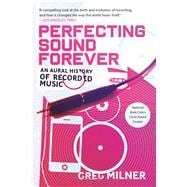
GREG MILNER has written about music, media, technology, and politics for Spin, Rolling Stone, The Village Voice, Slate, Salon, and Wired. He is the coauthor, with the filmmaker Joe Berlinger, of Metallica: This Monster Lives. He lives in Brooklyn.
| Liner Notes | p. ix |
| Intro: "Testing, Testing ..." | p. 3 |
| Acoustic/Electrical | |
| The Point of Commencement | p. 29 |
| From the New World | p. 50 |
| Analog | |
| Aluminum Cowboys: A Pretape Parable | p. 77 |
| Pink Pseudo-Realism | p. 104 |
| Presence | p. 129 |
| Digital | |
| Perfect Sound? Whatever | p. 185 |
| The Story of the Band That Clipped Itself to Death (and Other Dispatches from the Loudness War) | p. 237 |
| Tubby's Ghost | p. 293 |
| Outro: "Testing, Testing ... (Reprise)" | p. 347 |
| Notes | p. 373 |
| Acknowledgments | p. 393 |
| Index | p. 397 |
| Table of Contents provided by Ingram. All Rights Reserved. |
The New copy of this book will include any supplemental materials advertised. Please check the title of the book to determine if it should include any access cards, study guides, lab manuals, CDs, etc.
The Used, Rental and eBook copies of this book are not guaranteed to include any supplemental materials. Typically, only the book itself is included. This is true even if the title states it includes any access cards, study guides, lab manuals, CDs, etc.